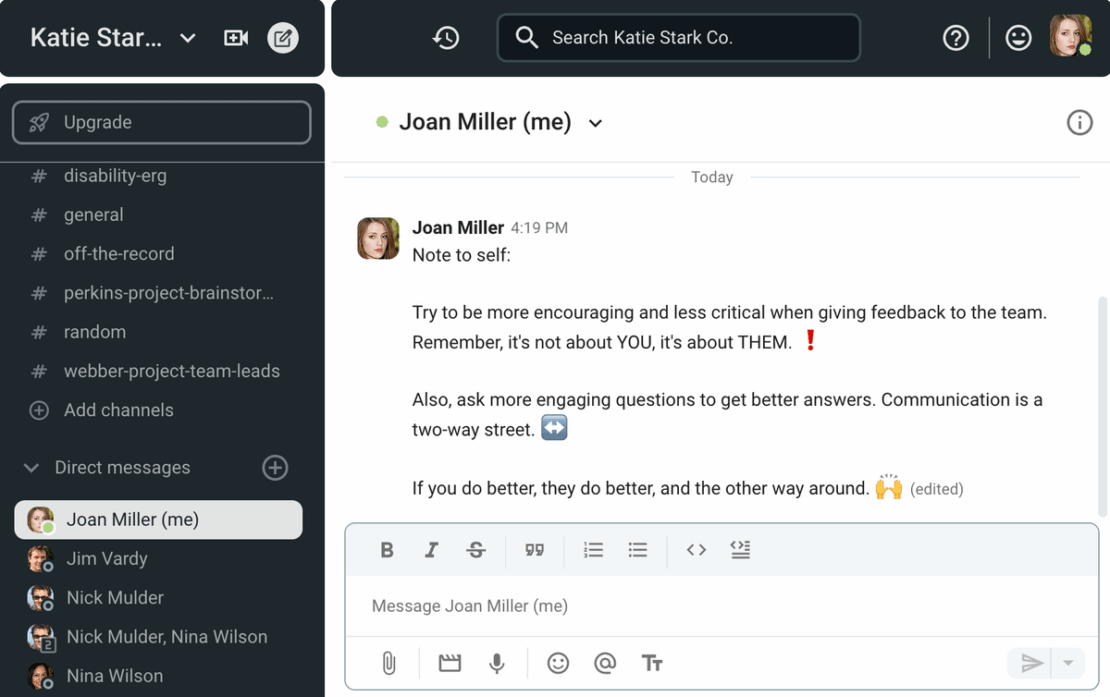Are your team members able to express their fears, doubts, or suggestions? Or, does everyone feel better off agreeing with the decisions you’ve already made?
If your employees trust you with their feelings and believe their voices will be heard, congratulations — you are an empathetic leader.
If not, don’t worry!
There’s a way to learn how to lead with empathy.
And we’ll show you just how, with a plethora of examples of empathy in the workplace, and advice from experts — it all starts with defining what exactly the empathetic leadership style is.
- 55% of CEOs claim they’re empathetic leaders, but only 28% of their team members agree, according to research.
- 87% of workers said that empathetic leadership inspires positive change within the workplace, a study shows.
- Empathetic leaders are great at conveying their thoughts and opinions — but, even more importantly, they are active listeners.
- Abraham Lincoln, Jacinda Arden, and Satia Nadella are some of the most famous examples of empathetic leaders.
What is empathetic leadership?
Empathetic leadership is a leadership style deeply rooted in showing empathy for team members through perceiving their emotional states.
Simply speaking, empathy means that we’re able to understand and recognize the emotions of others.
This doesn’t imply feeling sorry for others — that would be compassion.
Rather, empathy is the ability to understand why people feel the way they do, regardless of what we personally think of it.
As CEO Marie Unger explains, being an empathetic leader means “having a genuine interest in understanding the thoughts, feelings, and opinions of others, and embracing multiple perspectives.”
This type of leadership style has a positive impact on productivity. According to the EY US Consulting Study, 85% of employees link increased productivity with an empathetic leadership style.
However, it’s not easy to maintain this type of leadership, as research shows leaders feel they’re more empathetic than their team members believe.
Namely, the 2024 State of Empathy Report shows that 55% of CEOs claim they’re empathetic leaders, but only 28% of their team members share this impression.
What does it mean to be an empathetic leader?
An empathetic leader is someone who actively listens to their employees, takes a genuine interest in why they’re behaving in a certain way, and makes decisions that are based on empathy rather than on rigid policies.
The same leader exhibits self-awareness, has a high level of emotional intelligence, is trustworthy, reliable, honest, and an efficient communicator. At the same time, an empathetic leader is vulnerable, authentic, and flexible.
Essentially, an empathetic leader makes employees feel seen and understood.
Further reading:
Emotional intelligence is one of the most essential pillars of successful leadership. Read on to learn why.
Examples of empathetic leaders
One of the most famous empathetic leaders is the 16th president of the United States, Abraham Lincoln, who led America through the Civil War, and whose life mission was to understand the perspective of others — even when it seemed impossible.
Lincoln’s famous quote, “with malice toward none, with charity for all”, was a pillar of his leadership philosophy.
Another example of an empathetic leader is Jacinda Arden, the former PM of New Zealand. She strongly believes that there is strength in empathy:
“One of the criticisms I’ve faced over the years is that I’m not aggressive enough or assertive enough, or maybe somehow, because I’m empathetic, it means I’m weak. I totally rebel against that. I refuse to believe that you cannot be both compassionate and strong.” – Jacinda Arden
Finally, another who is said to lead with empathy is Satya Nadella, the CEO of Microsoft, a people-oriented leader who showed that your company can be wildly successful if you treat your employees with care and respect.
In fact, he claims that empathy is at the core of his actions in everyday life, not only at work:
“I have learned that when I infuse empathy into my everyday actions, it is powerful, whether they be in my role as a father or as a CEO.” – Satya Nadella
The importance of empathy in leadership
The answer to why empathy is important in leadership lies in the fact that empathy creates a work environment the employees want.
After all, as Unger believes the Great Resignation has shown us, “people want to work for companies where their voices matter and they feel valued.”
We all want a work environment brimming with trust, a sense of belonging, and authenticity, which makes empathy in leadership more important than ever.
And the research done so far just backs up these claims.
Namely, the EY US Consulting Study we mentioned earlier found that 87% of its participants think empathetic leadership inspires positive change within the workplace.
Further reading:
Apart from empathetic leadership, there are many other types of leadership styles. Here are some of them:
Actionable steps to develop and maintain empathetic leadership
There are steps that you can take to become an empathetic leader, increase empathy in the workplace, and create an environment where people will love working.
Note that you don’t have to be competitive about it — as Executive VP and Global CFO Rani Puranik emphasizes, leaders should embrace the inputs of other leaders, “especially when they have more experience — because every person has something valuable to contribute.”
With this disclaimer out of the way, let’s move on to practical examples of how you can improve your empathetic leadership.
Exercise active listening
You should exercise active listening as much as you can.
CEO, Author, Speaker, and Trainer Rob Volpe emphasizes the importance of paying attention to the person who is speaking to us:

“There’s wisdom in the expression ‘we learn more from listening than talking.”
And what does active listening look like in practice?
You stop what you’re currently doing, focus all of your attention on the person in front of you, and, once they stop speaking, you paraphrase what they said and ask for clarification, if necessary.
So, listen without any judgement — and don’t jump in with stories from your own experience or otherwise interrupt the speaker.
Ask good questions
Get into the habit of asking questions.
The empathetic leadership style implies that you have the ability to understand what is going on in your team. Questions are a great way to reveal any hidden dissatisfaction and communication glitches.
That’s why founder Kristen Nielsen Donelly, Ph.D, says “don’t assume that you know how everyone wants feedback, handles fluorescent lights, or feels about remote work. Ask them.”
Also, don’t be afraid of difficult conversations.
As Donelly states, “if you notice that one of your employees is a bit ‘off’ — ask them why instead of brushing it off.” According to Donelly, “things like that make a difference” and most importantly, enable demonstrating empathy in a simple way.

Reminders of empathetic leadership practices on Pumble
Practice self-awareness
Self-awareness is an ongoing process of observing your own behavior, asking others for feedback, and acknowledging that you need to work on your thoughts or actions.
Volpe shares that “it’s difficult to dismantle judgement if you aren’t able to have self-awareness of your own behavior and thoughts”.
For example, if you become aware that you don’t ask many spot-on questions at work, you can work on it. That’s how you can continue to develop your empathetic leadership skills.
The opportunities are endless here, and we agree with the Founder and CEO Kim Crowder, when she emphasises that “building this awareness will never be completed”.
Be honest and transparent
Being honest and transparent about processes, intentions, and reasoning behind decisions is demonstrating empathy, at its finest. This means that your team doesn’t fear any hidden agenda you may have.
As Art Shaikh, founder and CEO, puts it, empathetic leaders are “making sure that their team is aware of everything that is going on and why decisions are made.”
An example of this could be saying you’re not feeling completely OK today, instead of your usual “Everything’s great!” reply. CEO and Author Patrick Thean points out that to be empathetic “one must first be willing to be vulnerable and willing to share oneself in an authentic way.”
Take communication to the next level
Empathy in leadership is mirrored in the way you communicate with your team on a daily basis.
Volpe shares practical examples of phrases you can implement in your language when speaking to your employees.
These include “I understand where you are coming from” and “I can see your point of view”.
Apart from this, he adds that such acknowledgements should be “coupled with a statement reflecting that other perspective and how it is informing the decision being made.”
So, strive to become an effective communicator by incorporating useful phrases that reflect your leading with empathy.
Create an atmosphere of trust in your team
The empathetic leadership style leads to an atmosphere of trust in your company.
Actually, trust is so essential that Thean strongly believes that “without trust, it is impossible to gain learning about the other person to be empathetic.”
Thean then emphasizes that “trust is important if you want to retain your best employees”, and also “if you wish to make a positive impact on the people that you serve”.
Thean concludes that creating an atmosphere of trust “will help any leader be the best leader they can possibly be”.
So, building trust implies you need to be trustworthy in the first place. People need to know that they can rely on you and that you’ll make decisions that are in their best interest.
Be authentic
No formal empathetic leadership skills development course or training will ever be able to compensate for simply being authentic at work.
And how do you achieve this?
By following all the steps we already mentioned above. Become aware of your strengths and weaknesses, listen to others, take a real interest in your employees’ lives, be trustworthy, and as honest and transparent as possible.
For example, to be an authentic leader, you can connect with your employees by taking a moment and asking them to recommend their favorite movie, a new restaurant, or a band. And then you can share your recommendations and show them a different side to your personality.
Finally, allow yourself to be vulnerable. Thean shares that “vulnerability builds trust”, but we would also add that it connects you and your team on a much deeper level — as we are all humans after all.

Asking for a movie recommendation on Pumble
Let leading with empathy become your mission
Don’t be afraid of demonstrating empathy in your everyday leadership.
Although it may be scary in the beginning, the benefits that we mentioned — such as an atmosphere of trust in your team, higher productivity levels, and other positive changes in the workplace — are well worth any risk you may think is associated with being an empathetic leader.
How will you know if you succeeded?
Leading with empathy is a work in progress — you may make plenty of mistakes, but eventually, you’ll get there.
If your employees come to you for advice, or with a problem they’re facing, without hesitation — you’re on the right track.
Empathetic leadership can be made even easier with the team communication app Pumble, which is a part of our CAKE.com Bundle. It’s a place where you can efficiently share ideas, updates, future plans, personal stories, and much more. Check it out!




